Having all your applications work together to create a complete view of the customer feels like a dream. Now, you can make this vision a reality with CRM integration.

Integrations connect all of your applications with your CRM. If you need a specific app to organize your data, you can add it to the power of your CRM. Integrating your CRM can increase efficiency, enhance data accuracy, improve customer experiences, and increase sales.
Sounds amazing, right? This post will explore the importance of CRM integrations, how to leverage integrations for your business, and the wide range of available integrations you have to choose from.
Table of Contents
- What is a CRM integration?
- Benefits of CRM Integration
- How to Add CRM Integrations
- CRM Integration Tools
What is a CRM integration?
CRM integration is the seamless connectivity between your customer relationship management (CRM) software and third-party applications. Integrations result in automated actions that expand the functionality of your software, eliminating the need to toggle back and forth between systems.
Your CRM is not only essential for communicating with customers, but it should also create alignment and streamline communication within your company. A study from IDG found that 61% of IT executives reported that their companies use over 100 different software tools. That’s a lot of data in a lot of different places. CRM integration is essential for bridging the gaps among modern companies' various data points and tools.
With integration, you can create a single source of truth with all the necessary functionality for getting stuff done and keeping teams on the same page.
Benefits of CRM Integration
There are several benefits to integrating your CRM with the rest of your tech stack. An integrated CRM can be the central hub for all your business and customer data, ensuring your processes run smoothly. You can then create a 360-view of customer activity.
See other benefits of CRM integration below.
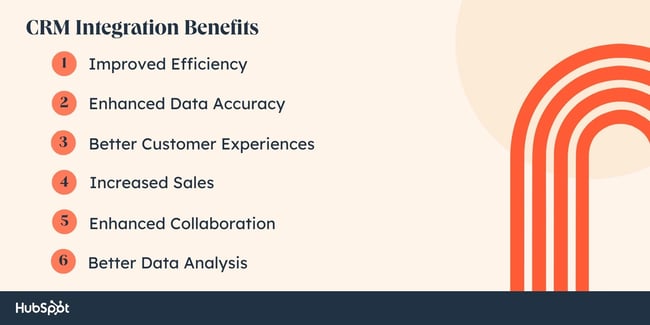
1. Improved Efficiency
By integrating your CRM with other systems, you can streamline internal processes. For example, adding automation software can reduce the effort spent on manual tasks such as data entry.
You’ll then have more time to GSD. (Get Stuff Done).
2. Enhanced Data Accuracy
CRM integrations can help ensure that data is accurate and up-to-date. How? CRM integration allows for the automatic syncing of data between your CRM and other systems. Accordingly, you can eliminate mismatched contact records or data silos that keep some teams in the dark.
For example, you can integrate HubSpot’s CRM with Shopify, which allows you to track who is buying what on your site. By integrating HubSpot and Shopify, the purchase data from Shopify gets automatically synced to corresponding contact records in HubSpot without you having to think about it.
3. Better Customer Experiences
Integrating your CRM with other tools can provide customers with more personalized and timely experiences.
If your CRM is integrated with your stack, you will always have a complete and up-to-date view of customer interactions, allowing you to personalize communications accordingly.
4. Increased Sales
With proper CRM integration, sales opportunities will never get lost in translation between systems. In addition, you can personalize marketing efforts without fear of inaccurate information. All this adds up to increased sales and revenue.
5. Enhanced Collaboration
CRM integration allows different teams and departments in your organization to access and share customer data, improving team communication and collaboration.
For instance, you can integrate HubSpot’s free CRM with numerous other tools, like live chat, landing page builders, and more. This ensures that customer data from marketing, service, and sales departments are neatly organized under a unified platform and easily accessible by everyone involved.
6. Better Data Analysis
An integrated CRM system provides valuable insights and analytics on customer behavior. With helpful information from all of your business systems summed in your CRM, you can create supercharged reports that will improve sales and marketing strategies and improve the customer experience.
Check out the video below to learn more about CRM integration and why it’s essential.
How to Add CRM Integrations
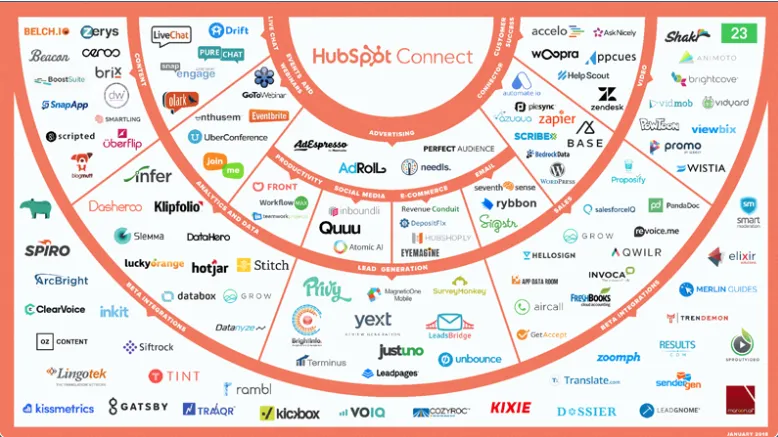
So, you want to create a CRM with all the apps your team usually uses. You can achieve CRM integration in multiple ways. Check out your options below.
1. Use built-in CRM integrations.
If you invest in products and services from one provider, your CRM will be integrated by default. For example, let’s say you use HubSpot CRM, Marketing Hub, and Service Hub. In that case, your systems will automatically connect, and you’ll never worry about accuracy and transparency.
This is a very convenient solution. However, you likely use multiple software from different providers at your business. Many companies use different providers for email, calendar, team communication, and more.
Luckily, every CRM will come with built-in connections to integrate commonly used systems with the click of a button. So, all you’ll need to do is identify which external apps you use and hook it up accordingly.
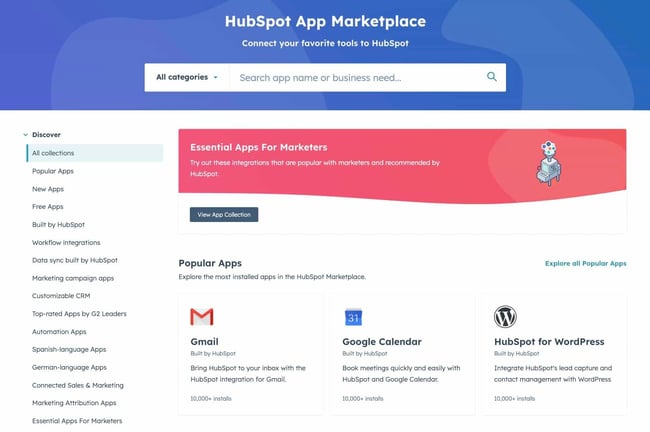
Common built-in integrations include:
- Gmail and Outlook for email.
- Slack for team communication.
- Social media integration with Facebook, LinkedIn, and Twitter.
- Google and Outlook for calendar.
- Survey Monkey and TypeForm for lead forms.
- Document and proposal software.
- Uber Conference, Aircall, and CallRail for calling/video chat software.
In addition, if you use HubSpot CRM, you can use the HubSpot Meeting Scheduling App to let prospects book meetings based on your real-time calendar availability.
See below for other standard integrations that are included in CRMs.
Customer Success Software
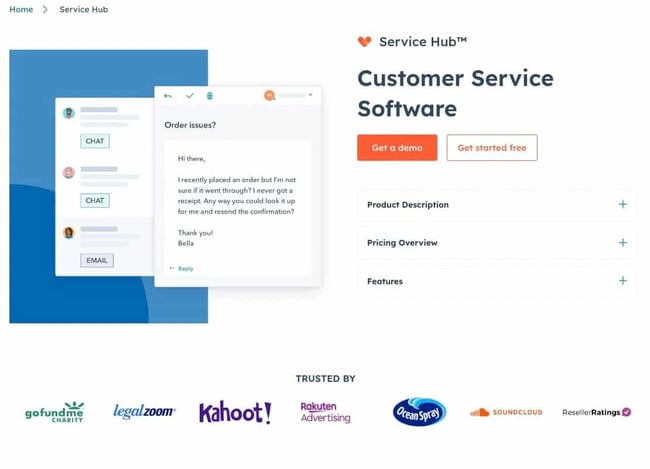
Integrating software such as Zendesk or Service Hub with your CRM will make valuable service data visible to all relevant teams. As a result, you can more efficiently solve customer problems and bolster future sales by approving your offering.
Plus, you can ensure customer service needs are always accounted for.
Live Chat
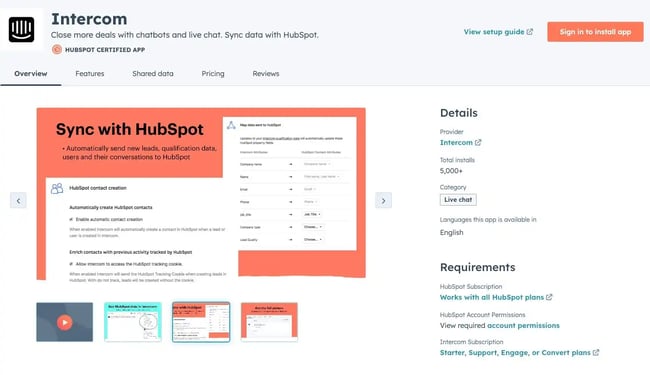
Live chat integrations, such as with Intercom, will easily capture conversation history in your CRM so you can always stay on top of customer needs and concerns. Plus, you’ll have a log of how you’ve solved past challenges that can be very helpful if issues pop up again.
Prospecting Software
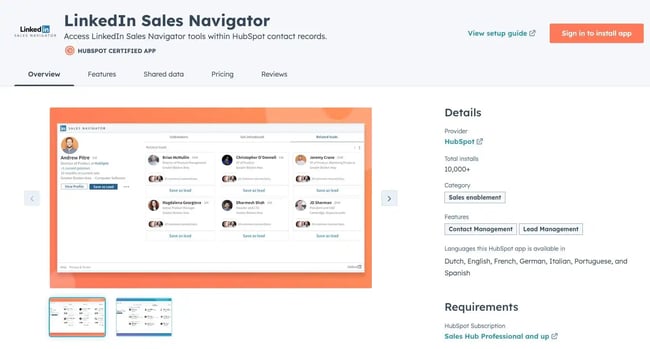
If you use a third-party tool to help identify and engage with prospects, you want to integrate it with your CRM to streamline communication.
Integrating a prospecting system such as LinkedIn Sales Navigator with your CRM enables you to engage leads with personalized outreach using features like InMail, related leads, and icebreakers within your CRM.
E-commerce Software
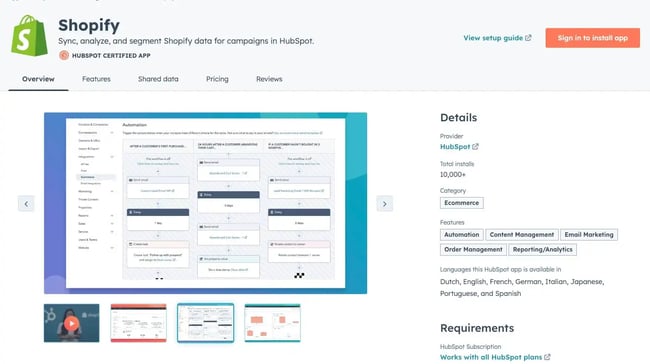
For sales reps working for e-commerce companies, integrating your online shopping cart platform with your CRM is critical to understanding your customers.
If your company uses a Shopify store to sell products, integrating the platform with your CRM can automatically sync products, contacts, and orders so you have access to pertinent shopper information.
If your company uses Stripe to manage online payments, integrating it with your CRM allows you to add new contacts who receive quotes automatically. This makes it even easier for customers to pay invoices and purchase orders directly without going back and forth.
Web Form Integrations
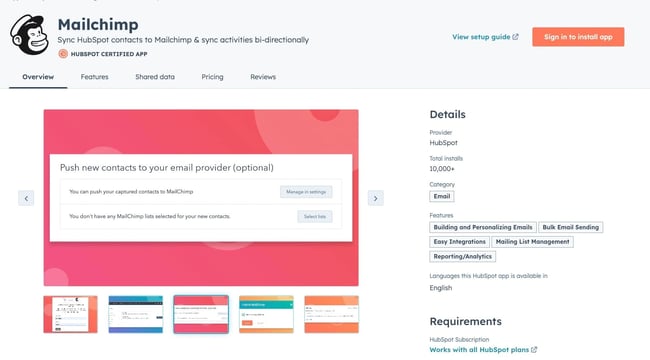
The lead generation forms on your website should automatically sync with your CRM. Integrating your CRM with web form software such as WordPress, Unbounce, or Mailchimp ensures that the valuable leads you capture with forms always show up in your CRM.
You’ll also ensure that your contact list is always up to date — no manual uploads required.
Event Software
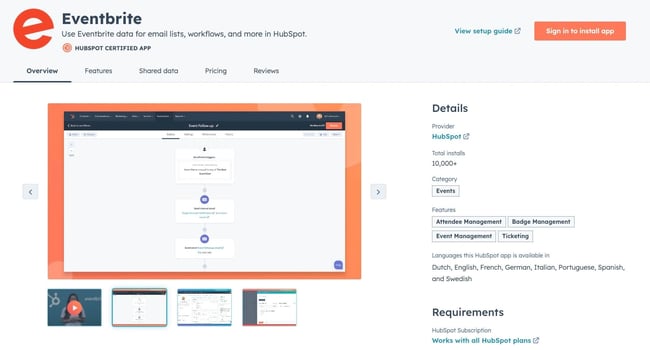
If your company facilitates in-person or virtual events, integrating your CRM with event management software is a helpful way to understand how event ticket sales and attendance impact your sales funnel.
If you use Eventbrite for live event ticketing, integrating this system with your CRM provides insightful data about which contacts are attending your events and how you can better connect with them in the future.
The same holds for virtual gatherings. Integrating your CRM with a system such as GoToWebinar can be timesaving for sales reps who focus on selling virtual tickets.
Connecting your webinar system with your CRM allows you to easily send registration reminders to your contact list, create follow-up campaigns, and create robust funnel reports to understand your event ROI.
Video Software
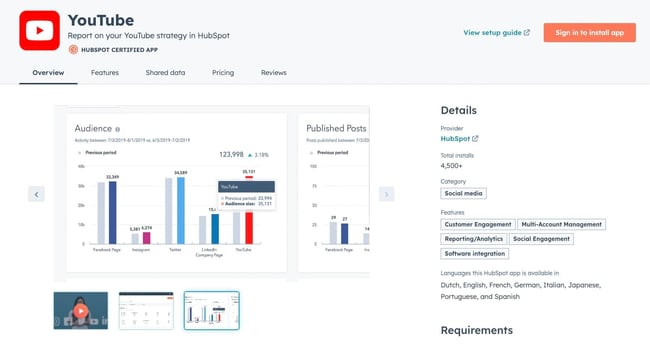
Integrating a video platform such as YouTube with your CRM can provide valuable insights about your leads if your marketing team uses video as part of their strategy. You’ll access data about the most successful videos and messages, giving you leverage as you engage with potential customers.
2. Leverage connector integrations.
Connector integrations act as third-party triggers or go-betweens to facilitate the connection between your CRM and thousands of other apps. Using connector software, you can create custom integrations to facilitate specific tasks to create automated workflows.
Our favorite connector integrations include Zapier, which automatically transfers information between your CRM and over 1,000 third-party apps along with Bardeen.ai, which automatically builds automation and integrations between your CRM and third-party apps with AI. Make offers another compelling option.
You can connect your CRM to 1,000+ apps to create workflows with Make. This lets you connect your CRM and automatically exchange data with all systems — from accounting and payment apps to project management platforms.
3. Build your own APIs.
APIs (application programming interfaces) are endpoints in your CRM and other software that define the protocol of how apps can interact. APIs allow different systems to communicate and exchange data, enabling your CRM system to share data with other applications.
The built-in integrations mentioned above are all built using behind-the-scenes APIs to connect the apps. With an IT team or development experience, you can manipulate APIs directly between your CRM and other apps to create more customized integrations.
API integration is helpful if you have specific needs or custom in-house software not included in standard built-in CRM integration options.
4. Write your own custom code.
Software developers can write custom code that will make different systems communicate with each other. However, this option can get messy fast.
While APIs are designed to work in a standardized and repeatable way, custom code must be updated constantly to keep up with updates and changes. For this reason, we recommend integrating your CRM with built-in options or APIs, unless you have highly specialized and complex needs.
CRM Integration Tools
Integrating your CRM with the rest of your technology stack is as easy as IPaaS!
What’s IPaaS?
Integration Platform as a Service is a breed of software tools to facilitate integration among disparate software. The IPaaS market was valued at $3.7 billion in 2021 and is expected to grow to $13.9 Billion by 2026. So, it’s clear that more and more businesses are waking up to the need to integrate their tech stacks.
CRM integration is especially relevant since most businesses use CRM as their central customer data hub. Read on to learn about the Top 6 CRM integration tools that can help you integrate your CRM with the rest of your business tech.
1. Zapier
.webp)
Zapier is a popular tool that allows you to integrate web applications and automate workflows. Also known as an Integration Platform as a Service (IPaaS), Zapier orchestrates the data flow between applications that otherwise wouldn’t be connected.
You can think of Zapier as a middle-man application. According to the rules and workflows you set, Zapier triggers when an action occurs in one application, which then starts a corresponding action in another application. So, for example, you can set up Zapier to activate when a contact is created in your email list, which then triggers the creation of a corresponding contact in your CRM.
What we like: Zapier’s visual automation pathways are intuitive and make setting up if/then workflow rules simple.
Pricing: A free plan is available. Starter plans cost $19.99 monthly. Professional plans cost $49 monthly. Team plans cost $399 monthly. Company plans cost $799 monthly.
2. Bardeen.ai
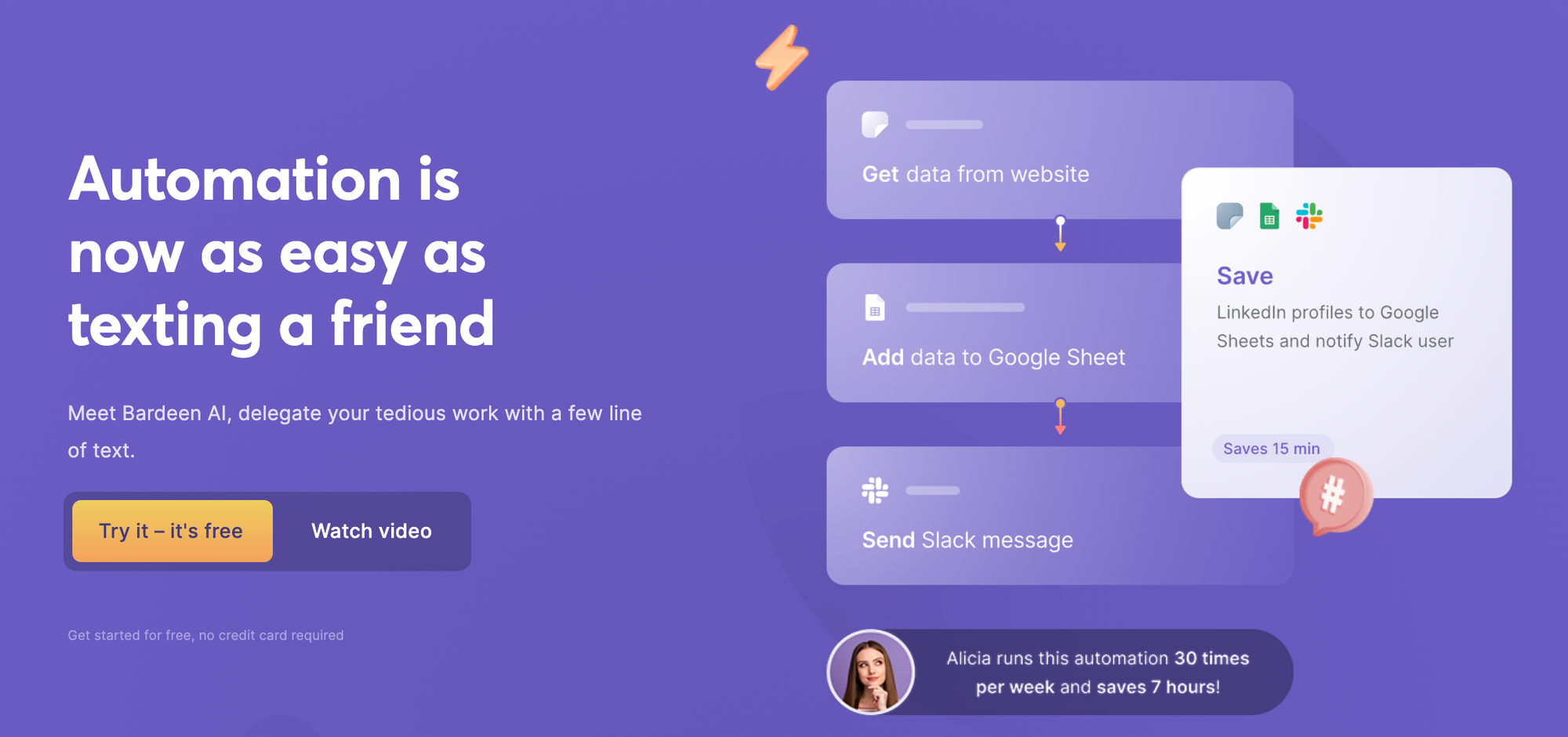
Image Source
Bardeen is an AI automation tool designed to optimize workflows. Using Bardeen.ai makes automation as straightforward as sending a text message. Whether it's maintaining a clean and updated CRM, personalizing outreach campaigns, or synchronizing data across various tools used by your internal team, Bardeen can streamline your workflow with AI.
The ability to integrate with CRMs like HubSpot and over 100 other integrations simplifies the automation of numerous processes, enhancing productivity. Bardeen is designed for companies of all sizes aiming to optimize their marketing and sales automation initiatives. With thousands of ready-to-use automation templates available, getting started is straightforward.
What we like: Bardeen's AI automation platform generates automation using text prompts. It features numerous potent, ready-to-use AI and browser-based automation actions.
Pricing: Free forever plan; Professional plan starts at $10/month.
3. Integrately

Integrately is an automation software that boasts an easy-to-use interface and over 8 million pre-built workflows with 1000s of apps. Integrately can get your CRM integration up and running quickly with their one-click automations, which are pre-built workflows that, as the title suggests, you can set up with a single click.
Integrately has over 2,500 integrations with HubSpot to connect your CRM to Trello, Instagram, Twilio, Chat GPT, and more.
What we like: Integrately’s extensive library of one-click automations removes the headache of CRM integration.
Pricing: Starter plans cost $19.99 monthly. Professional plans cost $39 monthly. Growth plans cost $99 a month. Business plans cost $239 monthly.
4. Celigo

Celigo is a robust IPaaS that is aimed at larger businesses. Despite its robust feature set, Celigo retains a smooth, intuitive interface facilitated by 1000s of pre-built integrations. As a result, Celigo can act as the integration layer for an entire enterprise-worth of business apps to eliminate data silos and facilitate data transparency across large organizations.
For example, WeTransfer was at one point using over 200 paid SaaS applications to run their operation, most of which were purchased ad-hoc and did not integrate. They turned to Celigo to clean up and integrate their stack, saving $200k annually in operational costs.
Best for: Large companies with complex integration needs who can benefit from Celigo implementation services and custom integrations.
Pricing: Standard plans cost $600 monthly. Premium plans cost $1200 monthly. Enterprise plans cost $2500 monthly. A free trial is available.
5. Boomi
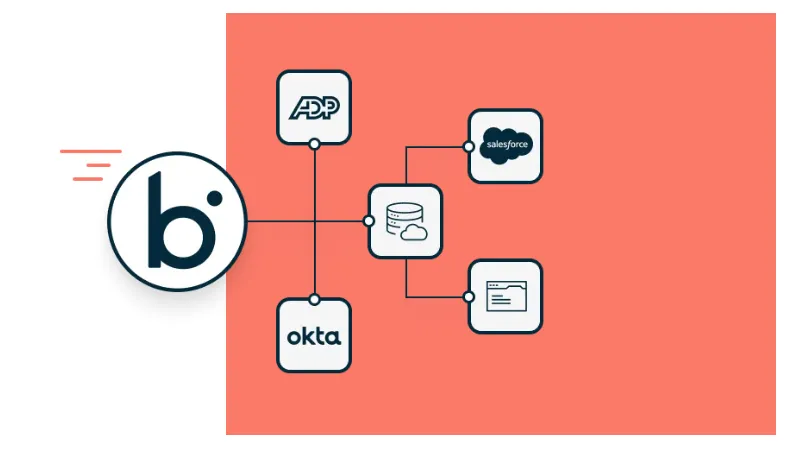
Pricing: Boomi pricing is available upon request and custom based on business needs
Boomi is a top choice in the IPaaS space for its reliability, speed, scalability, and ease of use. Using Boomi, you can integrate your CRM seamlessly with the rest of your tech stack using 1000s of pre-built integrations or creating custom automation and workflows.
In a case study by Forrester Consulting, researchers found that customers using Boomi reduced their integration development times by 65%, which equates to an increased efficiency value of over $3.7M.
What we like: Boomi’s AI-based integration guidance feature, which can suggest integration pathways and automation based on machine learning of over 200M previous integrations.
6. MuleSoft
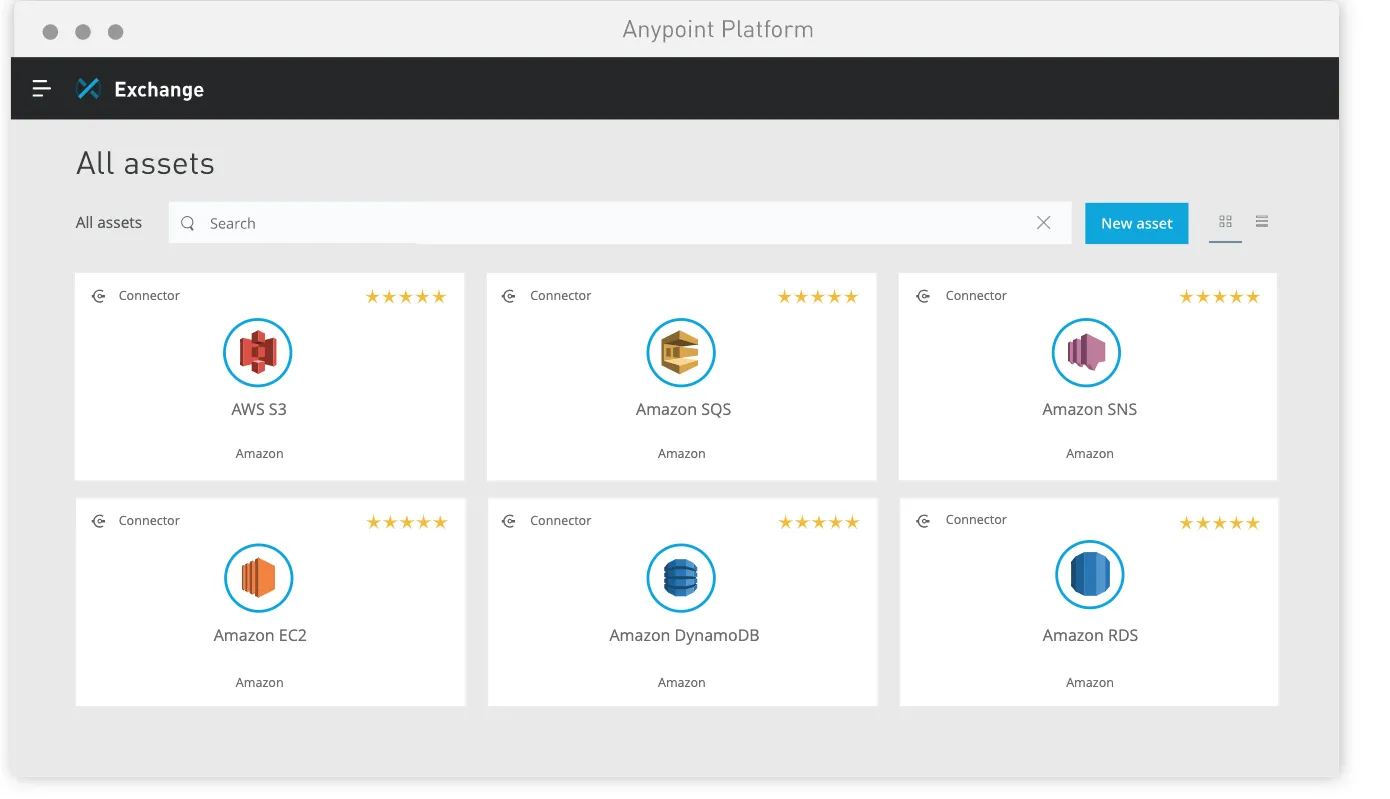
MuleSoft is a top-tier integration platform (IPaaS) with many options for businesses of all shapes and sizes. You can use their drag-and-drop interface to quickly set up pre-built integrations or get more granular with API management to create custom integration solutions.
MuleSoft helps you connect and manage various data sources, including CRM, for a reported 74% reduction in maintenance effort and cost among other customers.
Best for: Companies with development capabilities who wish to take advantage of MuleSoft’s API framework for creating custom integration solutions
Pricing: MuleSoft pricing is custom based on the number of API requests needed.
7. Jitterbit

Jitterbit is an IPaaS with a focus on simplicity. Using Jitterbit, you can easily integrate your CRM with the rest of your data and business processes. Jitterbit comes packed with hundreds of pre-built integrations for common business processes, so you can hit the ground running no matter what software you’re using.
Jitterbit doesn’t just connect web applications. You can also use Jitterbit to integrate legacy software and on-site data into your CRM and the rest of your stack.
What we like: Jitterbit’s easy-to-use interface is a standout in terms of looks and functionality.
Pricing: Custom pricing is available based on your requirements.
Getting Started With CRM Integration
CRM integration with an ever-expanding number of business tools will only become more critical as your business grows. As a result, it’s essential to consider which integration method is best for your business carefully.
Factors to consider are your budget, the complexity of the integration, and the level of customization needed.
Editor’s note: This post was originally published in October 2019 and has been updated for comprehensiveness.

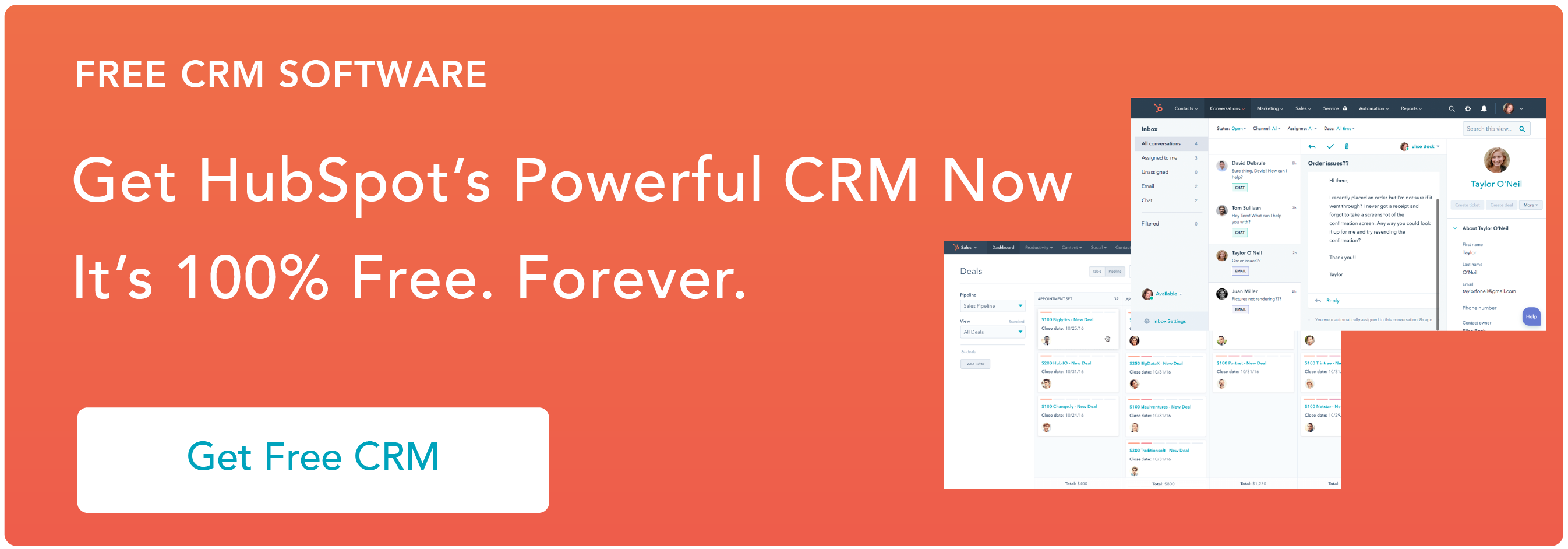



![The Importance of a CRM: Why Your Company Needs a CRM to Grow Better [New Data]](https://www.hubspot.com/hubfs/1-Feb-23-2021-12-59-16-65-AM.jpg)




